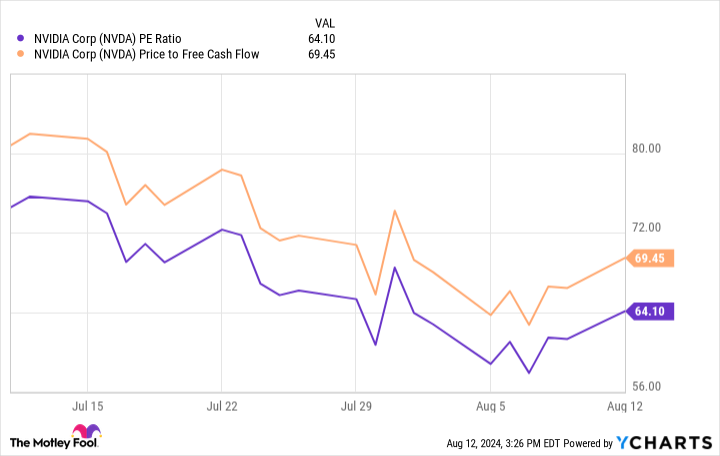The capital markets got off to a roaring start in 2024. However, the S&P 500 and Nasdaq Composite have given back some of their gains over the last month or so as equities have experienced some pronounced selling activity. As of the time of this article, shares of artificial intelligence (AI) darling Nvidia (NASDAQ: NVDA) have fallen nearly 14% in the last month.
While some of the decline can be attributed to sell-offs in the broader market, Nvidia recently hit investors with some disappointing news. Should investors be bothered by this dilemma, or is this a rare chance to buy the dip in AI’s hottest stock?
What’s going on with Nvidia stock?
There are a lot of factors influencing Nvidia stock’s recent price action.
For starters, the unemployment rate unexpectedly rose to 4.3% in July — its highest level in over two years. Moreover, recent commentary from the Federal Reserve continues to have economists questioning whether or not a cut to interest rates is on the horizon or not.
All things considered, the cloudy macroeconomic picture coupled with some typical election-driven volatility has surely caused some investors to start selling stock and hoard cash amid a pool of uncertainty. Unfortunately, this is only one side of the equation for Nvidia investors. Perhaps most concerning of all is that Nvidia’s highly anticipated Blackwell graphics processing unit (GPU) is facing delays due to design flaws, according to several media outlets.
Considering companies of all sizes and every industry are doubling down on generative AI investments, Nvidia’s Blackwell delay doesn’t exactly inspire confidence. Nevertheless, I don’t think this is necessarily a reason for investors to hit the panic button just yet.

Why the Blackwell delay isn’t a big deal
While estimates vary, public research suggests that Nvidia owns at least 80% of the AI chip market. So, while a delay to the Blackwell launch may be a lowlight, it’s extraordinarily unlikely that Nvidia will lose significant market share as a result of this design blunder.
Chief Investment Officer of Harvest Portfolio Management Paul Meeks recently expressed a similar sentiment during an interview on CNBC. He makes a great point in that demand for Nvidia’s GPUs is so high that the company will have no real problem selling the Blackwell chips once they actually come to market — regardless of the delay.
“I just need to see these stocks stabilize for a couple of sessions at some sort of trough level.”
Harvest Portfolio Management Co-CIO Paul Meeks is closely watching the technicals as he discusses why he isn’t buying the dip in tech just yet: pic.twitter.com/XqsOM9qABO
— Money Movers (@moneymoverscnbc) August 5, 2024
Additionally, each of the “Magnificent Seven” companies has reported earnings this season except Nvidia. One of the common threads stitching mega-caps together is that spending on AI-powered products and services has steadily risen over the last year. In particular, capital expenditures (capex) have been on the rise among mega-cap tech as demand for cloud computing infrastructure, data center services, and semiconductor chips increases.
Considering that the bulk of Nvidia’s revenue growth currently stems from hardware operations in chips and data centers, I think the rising investment in capex among big tech companies represents a compelling secular narrative around Nvidia’s bright future.
Buy the dip like there’s no tomorrow
When investors are hit with some distressing news, it’s always important to zoom out and consider all the variables.
Back in 1997, Apple nearly filed for bankruptcy. Today, Apple is the largest company in the world by market cap. Even the best companies hit road bumps from time to time. What’s more important is how management navigates these challenges in the moment.
The chart below illustrates Nvidia’s price-to-earnings (P/E) ratio and price-to-free cash flow (P/FCF) multiple over the last month. While a 14% drop in Nvidia stock may not seem like a lot in the grand scheme of things, the compression this decline has made on valuation multiples in such a short timeframe shouldn’t be overlooked.
Outside of its GPUs, the company is quietly building a software platform to complement the core chip business. Additionally, the company has made a number of strategic investments in areas such as robotics to further diversify its AI ecosystem.
I don’t see any of these initiatives as priced into Nvidia stock at the moment. In fact, I think much of what Nvidia is doing outside of GPUs is not yet fully understood. For these reasons, I think the reaction to the Blackwell delay is overblown and view the recent sell-off as a no-brainer opportunity to buy Nvidia stock right now as further gains look to be in store over the long run.
Should you invest $1,000 in Nvidia right now?
Before you buy stock in Nvidia, consider this:
The Motley Fool Stock Advisor analyst team just identified what they believe are the 10 best stocks for investors to buy now… and Nvidia wasn’t one of them. The 10 stocks that made the cut could produce monster returns in the coming years.
Consider when Nvidia made this list on April 15, 2005… if you invested $1,000 at the time of our recommendation, you’d have $763,374!*
Stock Advisor provides investors with an easy-to-follow blueprint for success, including guidance on building a portfolio, regular updates from analysts, and two new stock picks each month. The Stock Advisor service has more than quadrupled the return of S&P 500 since 2002*.
*Stock Advisor returns as of August 12, 2024
Adam Spatacco has positions in Apple and Nvidia. The Motley Fool has positions in and recommends Apple and Nvidia. The Motley Fool has a disclosure policy.
Amid a 14% Sell-Off, Nvidia Just Hit Investors With a Rude Awakening. What Should Investors Do? was originally published by The Motley Fool
Source Agencies


